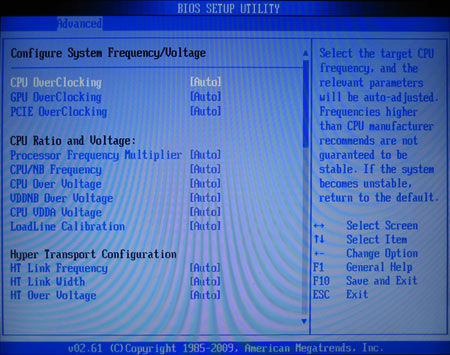Seven AMD 785G-Based Motherboards Rounded Up
Asus M4A785TD-V EVO: BIOS And Overclocking
A list of voltage and frequency ranges can be found on page 21 of this review.
The Asus M4A785TD-V EVO has a good degree of BIOS control, only really missing southbridge voltage controls. The only other value-added capability we would have liked to see would have been a BIOS profile-saving feature.
It's interesting to note that in order for the board to reach as-advertised 1,800 MHz memory speeds, it has to rely on an overclocked reference clock, as the highest selectable memory speed in the BIOS is 800 MHz (1,600 MT/s). We didn't have 1,800 MHz DDR3 available for testing, but we can say that the board handled our Mushkin XP3-12800 at 1,600 MHz with its advertised 7-8-7-20 timings and encountered no stability issues whatsoever. The M4A785TD-V EVO was only one of the two boards in our 785G roundup that could accomplish this feat.
Enabling AMD's ACC feature in the BIOS wouldn't wake any dormant CPU cores in our X3 or X2 samples, but it also wouldn't crash the system.
[Edit: Similar to the Gigabyte and MSI boards, the ASUS M4A785TD-V EVO has an option in the BIOS that allows the user to change the way AMD's ACC feature works: it is called "Unleashing Mode", and it only shows up once ACC is enabled. If Unleashing Mode is left at the default setting when ACC is enabled, you won't unlock any dormant CPU cores, but you might get the improved overclocking headroom from an original Phenom processor. However, if Unleashing Mode is set to “enabled,” it allows for CPU cores to be unlocked. This is a great feature because most other boards only offer one type of ACC operation: either they will unlock dormant CPU cores and crash an unwilling processor, or they will not unlock dormant CPU cores and allow for more overclocking tolerance.
The Unleashing Mode setting allows the user to choose what works best for them. We tested this feature and found that it worked great, allowing our Phenom II 550 BE to run stably with the ACC feature enabled without unlocking the dormant CPU cores. This same Phenom II 550 would crash when the “Unleashing Mode” option was enabled in conjunction with ACC, because the locked cores were faulty. However, our Phenom II X3 705e sample would work with all four cores enabled when "Unleashing Mode was used.]
Overclocking the integrated graphics processor was a breeze, and even without a dedicated GPU voltage adjustment in the BIOS, the Asus board met the ASRock's maximum stable graphics processor overclock. We took it to 1,000 MHz from 500 MHz stock for an impressive performance increase without touching any voltage adjustments. We did try upping the northbridge voltage to 1.355V, but it didn't make a difference, as we weren't able to push the GPU any further.
Get Tom's Hardware's best news and in-depth reviews, straight to your inbox.
Current page: Asus M4A785TD-V EVO: BIOS And Overclocking
Prev Page Asus M4A785TD-V EVO: Features And Hardware Next Page Biostar TA785GE 128M: Features And HardwareDon Woligroski was a former senior hardware editor for Tom's Hardware. He has covered a wide range of PC hardware topics, including CPUs, GPUs, system building, and emerging technologies.
-
JohnnyLucky Very informative article. Nice to see there are motherboards with different features for different users/tasks.Reply -
bpdski Great article, I think this shows pretty conclusively that there is no benefit to upgrading to an AM3 based system. If you already have an AM2+ system, you can easily just drop in a new CPU and you system will be every bit as good as a brand new system with DDR3. You just need to make sure your motherboard supports the power requirements of whatever you want to drop in.Reply -
jonpaul37 Hooray AMD for having cheap solutions in these hard-economic times!Reply
Boo @ Intel! i like the product, but my wallet & Girl do not like the cost! -
jonpaul37Hooray AMD for having cheap solutions in these hard-economic times!Boo @ Intel! i like the product, but my wallet & Girl do not like the cost!+1Reply
Girl has more money for clothes! -
ominous prime Well bpdski there is no point upgrading if you're AM2, but if you're building a new PC AM3 is the way to go in terms of your computers longevity. Very informative article.Reply -
sonofliberty08 thanks alot for the info , my first choice was allways asus , but now i now what i need when im going to unlock core , and now i saw the benefits of sideport memory .Reply -
duzcizgi ReplyWe were successful in achieving a 900 MHz stable overclock with the integrated graphics chipset by setting the BIOS to increase northbridge voltage by +.210mV.
Well, .210 mV = 210 microvolt. I don't think it would make much of a change. Maybe it is 210 mV or, .210 V. :) -
doron "Now we're seeing another benefit for the AM2+/DDR2 boards: both the Foxconn Cinema Premium and Biostar TA785GE 128M are drawing less power than their AM3/DDR3 counterparts."Reply
How comes? Didn't we all agree a long time ago that ddr3 supposed to be more energy efficient out of the two? (Lower voltage and stuff?) -
DarkMantle Great article, this will help a lot of people to make their AMD budget motherboard choice easier, thank you Don.Reply

